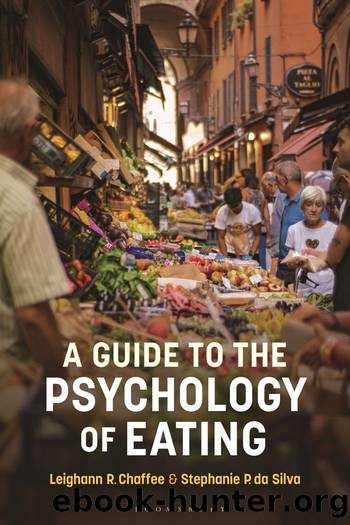A Guide to the Psychology of Eating by Leighann Chaffee Stephanie da Silva

Author:Leighann Chaffee, Stephanie da Silva
Language: eng
Format: epub
Publisher: Bloomsbury Publishing Inc
Stereotyped Beliefs
Food helps define the person consuming it and the culture to which they belong. When observing specific acts of eating or drinking in someone, we often draw general conclusions about them, a tendency called correspondence bias (Gilbert & Malone, 1995). That is, othersâ behavior is interpreted as stable and attributed to personality (âWow, sheâs a big drinkerâ in referring to someone who has over-enbibed on a rare occasion we happen to observe; Gilbert & Malone). Comparatively, variations and contextual factors in our own eating and drinking are recognized and articulated (e.g., âIâm not eating very much tonight because I had a late lunchâ).
Because observed consumption in others is viewed as stable and permanent, eating and drinking habits are noted and remembered as characteristics of people or groups to which they belong. In other words, observing others eat and drink can lead to stereotypes or beliefs about their consumption. One example is the belief that people in England drink hot tea; for many English, the stereotype may be true but it could be a mistake to assume that a person from England drinks tea (as Author SS once did when she took her British colleague a set of teas for her birthday only to be told that they prefer coffee). Stereotypes comprise the cognitive component of prejudices, or prejudgments, which also include affective and behavioral components. Prejudices are attitudes, or evaluations, toward things, events, or people. We could be prejudicedâforming premature attitudesâtoward foods, drinks, restaurants, people, and so on as they relate to consumption. When a restaurant names itself by a particular label, immediate attitudes are formed about the type of experience the restaurant will offer, including its food and drinks. These prejudices can be negative, making us less likely to visit the restaurant, or positive, making the restaurant alluring. Negative prejudices can escalate or manifest in discrimination, the differential treatment of a person or group based on some characteristic or membership. One example is known colloquially as âlunchbox bullying,â and involves children being teased and harassed for bringing particular foods in their lunchbox that do not fit local cultural norms (White, 2011).
Media portrayals of consumption and its related products can perpetuate stereotypes and prejudices surrounding consumption. The outgroup homogeneity effect, a tendency to view all members of a group or similar groups as sharing similar characteristics, occurs when there is little interaction between food cultures. An example is a tendency for non-Asians to imagine and picture all Asian dishes to be eaten with chopsticks. Presumed use of chopsticks is an incorrect generalization, or overgeneralization, because people from the Philippines, Indonesia, and several other Asian countries eat with forks. From private food bloggers to large corporations, misrepresentations occur and drive misunderstanding. And overlooked differences among cultures can be offensive (see microaggressions) and maintain stereotypes. Consumption varies a great deal within cultures, or across individuals. Media messages can foster superficial insights or flexible, nuanced, and more accurate perceptions.
Chew on This: Microaggressions in Food Branding
Microaggressions occur when messages subtly work against images, information, or rights of marginalized groups.
Download
This site does not store any files on its server. We only index and link to content provided by other sites. Please contact the content providers to delete copyright contents if any and email us, we'll remove relevant links or contents immediately.
What's Done in Darkness by Kayla Perrin(26619)
The Fifty Shades Trilogy & Grey by E L James(19100)
Shot Through the Heart: DI Grace Fisher 2 by Isabelle Grey(19083)
Shot Through the Heart by Mercy Celeste(18955)
Wolf & Parchment: New Theory Spice & Wolf, Vol. 10 by Isuna Hasekura and Jyuu Ayakura(17139)
Python GUI Applications using PyQt5 : The hands-on guide to build apps with Python by Verdugo Leire(17026)
Peren F. Statistics for Business and Economics...Essential Formulas 3ed 2025 by Unknown(16900)
Wolf & Parchment: New Theory Spice & Wolf, Vol. 03 by Isuna Hasekura and Jyuu Ayakura & Jyuu Ayakura(16841)
Wolf & Parchment: New Theory Spice & Wolf, Vol. 01 by Isuna Hasekura and Jyuu Ayakura & Jyuu Ayakura(16470)
The Subtle Art of Not Giving a F*ck by Mark Manson(14385)
The 3rd Cycle of the Betrayed Series Collection: Extremely Controversial Historical Thrillers (Betrayed Series Boxed set) by McCray Carolyn(14158)
Stepbrother Stories 2 - 21 Taboo Story Collection (Brother Sister Stepbrother Stepsister Taboo Pseudo Incest Family Virgin Creampie Pregnant Forced Pregnancy Breeding) by Roxi Harding(13678)
Scorched Earth by Nick Kyme(12788)
Drei Generationen auf dem Jakobsweg by Stein Pia(10985)
Suna by Ziefle Pia(10903)
The Ultimate Python Exercise Book: 700 Practical Exercises for Beginners with Quiz Questions by Copy(10620)
D:\Jan\FTP\HOL\Work\Alien Breed - Tower Assault CD32 Alien Breed II - The Horror Continues Manual 1.jpg by PDFCreator(10586)
De Souza H. Master the Age of Artificial Intelligences. The Basic Guide...2024 by Unknown(10552)
Scythe by Neal Shusterman(10370)
